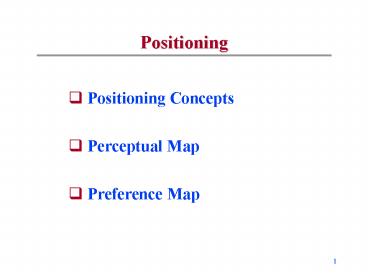Positioning - PowerPoint PPT Presentation
1 / 22
Title: Positioning
1
Positioning
- Positioning Concepts
- Perceptual Map
- Preference Map
2
Positioning Concepts
- Differentiation (What you do to a product)
creating tangible or intangible differences on
attributes/preferences of competitive offerings. - Positioning (What you do to the minds of
customers) strategies to differentiate a firms
offering in the minds of target customers
distinct, important, sustainable image. - Mapping techniques to develop differentiation
and positioning strategies by visualizing the
competitive market structure as perceived by
customers. - Based on customers attribute perceptions, and/or
preferences of existing (and/or new) products - At the individual, segment, or market level
3
Objectives of Using Maps
- 1. Check how customer perceptions of your
products compare to those of your competitors. - 2. Find (inadequately) unmet customer needs and
wants. - 3. Identify market segments to which a particular
product or new concept would be appealing. - 4. Identify product strengths and weaknesses, and
determine the direction of change on key product
attributes to improve your products. - 5. Visually determine the impacts of
re-positioning on market performance
(before-after study).
4
Some Successful Examples
1000 songs Safety Authentic, real,
original Family entertainment Improves the
quality of life Accepted everywhere Quality of
life
- iPod
- Volvo
- Coke
- Disney
- GE
- Visa
- Viagra
5
Why Mapping?
An chemist reads diagrams like this
An Electrical Engineer reads diagrams like this
Positioning 5
6
Why Mapping? (contd)
Ratings of nine brands of notebook computers on
several attributes B1 B2 B3 B3 B4 B5 B6 B7 B8 New
Attractive 5.1 3.6 3.5 5.4 3.9 4.8 5.2 4.0 5.2 4.
0Light 6.0 3.5 5.0 3.9 3.3 5.3 5.0 2.5 5.5 2.5Un
reliable 3.4 4.1 4.5 2.1 4.5 2.7 4.5 3.7 2.5 3.8P
lain 1.5 4.1 2.9 2.3 4.5 2.7 3.5 4.3 2.2 5.2Batte
ry life 3.3 4.9 4.3 4.1 3.9 3.0 3.5 6.2 3.5 4.0Sc
reen 3.5 5.3 3.4 6.4 5.4 5.2 3.3 6.0 3.3 4.8Keybo
ard 2.6 3.5 2.5 3.4 3.8 3.3 2.8 5.0 4.3 4.7Roomy
5.5 4.3 5.4 3.1 3.4 3.3 4.7 3.5 4.3 4.2Easy
service 4.5 4.9 3.3 5.0 4.4 4.5 3.3 4.7 3.8 4.5Ex
pandability 5.5 4.3 5.4 3.1 3.4 3.3 4.7 3.5 4.3 4.
2Setup 5.6 3.5 5.6 5.4 2.5 4.2 5.2 3.3 5.8 2.5Co
mmon 4.1 3.5 3.3 2.9 4.0 4.3 2.2 4.2 3.3 4.2Value
3.5 4.8 4.4 3.6 3.6 2.7 3.2 4.7 3.5 4.0Preferenc
e 7.4 3.4 4.8 6.6 4.4 7.4 7.1 3.8 6.9 3.3
7
Conventional Mapping Snake Charts
Does notDescribes it describecompletely
it at all 0 1 2 3 4 5
- 2 Products, 20 Attributes
- 1. Company provides adequate insurance coverage
for my car. - 2. Company will not cancel policy because of
age, accident experience, or health problems. - 3. Friendly and considerate.
- 4. Settles claims fairly.
- 5. Inefficient, hard to deal with.
- 6. Provides good advice about types and amounts
of coverage to buy. - 7. Too big to care about individual customers.
- 8. Explains things clearly.
- 9. Premium rates are lower than most companies.
- 10. Has personnel available for questions all
over the country. - 11. Will raise premiums because of age.
- 12. Takes a long time to settle a claim.
- 13. Very professional/modern.
- 14. Specialists in serving my local area.
- 15. Quick, reliable service, easily accessible.
- 16. A good citizen in community.
- 17. Has complete line of insurance products
available.
8
Read Perceptual Maps!
9
Mapping Methods Overview
- 1. Mapping perceptions
- Attribute-ratings methods (particularly useful
for functional products) - Overall-similarity methods (particularly useful
for image-oriented products) - 2. Mapping preferences
- Ideal brand as a brand
- Preference as a special attribute
10
1. Perceptual Maps
Example Positioning of Beers
- Select Beers of interest to the target customers.
- Identify key attributes on which these Beers are
evaluated by the target group (e.g., focus
groups). - e.g., Light-Heavy Cheap-Expensive Drink
alone-Share with friends - Ensure that customers are familiar with the
products. - Have customers evaluate the products on the
chosen set of attributes. - If desired, include Preference for the Beers as
one of the attributes.
11
Perceptual Map of Beer Market (Show Only
Attributes)
Heavy
Popular with Men
Heavy
Full Bodied
Special Occasions
Blue Collar
Dining Out
Premium
Good Value
Premium
Budget
Popular with Women
Pale Color
On a Budget
Light
Less Filling
Light
12
Interpreting Perceptual Maps
- Arrows
- Indicate the direction in which an attribute is
increasing (decreasing in the direction opposite
to the arrow). - Thus, a beer positioned farther and farther in
the North East direction are popular with men,
whereas a beer positioned in the South West is
less popular with men. - Length of the Arrows
- From the origin to the arrow, is an indicator of
the extent to which these beers are different on
that attribute. - Thus, Good value and Less filling are
relatively more important than Pale color and
Blue collar in explaining how these customers
discriminate between the different beers.
13
Interpreting Perceptual Maps
- Underlying dimensions
- Attributes that are both relatively important and
close to the horizontal (vertical) axis help
articulate the meaning of that axis. - Budget-Premium for the horizontal axis and
Light-Heavy for the vertical axis. - Horizontal axis premium, good value, special
occasions, blue collar, budget, etc. - Vertical axis heavy, light, pale color
14
Perceptual Map of Beer Market (Show Only
Products)
Old Milwaukee
Budweiser
Becks
Meister Brau
Heineken
Miller
Coors
Strohs
Michelob
Coors Light
Miller Lite
OldMilwaukee Light
15
Perceptual Map of Beer Market (Include Both
Attributes And Products)
Heavy
Popular with Men
Heavy
Full Bodied
Old Milwaukee
Budweiser
Becks
Meister Brau
Heineken
Special Occasions
Miller
Blue Collar
Dining Out
Premium
Good Value
Coors
Premium
Budget
Strohs
Michelob
Popular with Women
Coors Light
Miller Lite
Pale Color
On a Budget
OldMilwaukee Light
Light
Less Filling
Light
Interesting web site to visit www.ratebeer.com
16
Interpreting Perceptual Maps
- Product attribute perceptions
- To position a beer on an attribute, draw an
imaginary perpendicular line from the location of
that beer onto that attribute (the dashed lines). - For example, Budweiser is perceived to be more
popular with men than Coors.
17
2. Mapping Preferences
- Objective include preferences into perceptual
maps - Ideal point method introduce an ideal brand as
an additional brand evaluated on all attributes. - Combine attribute ratings of ideal brand with the
other brands. - Compare how different the brands are from the
ideal brand. - Vector method introduce preferences as an
additional attribute for all brands. - Analyze preference simultaneously with other
attributes. - Identify which attributes influence preference
the most - Identify which brands are most preferred.
18
Preference Maps
Vector Map
Preference Vector
A
dAC
dAB
C
B
(b)A is preferred to B and B is preferred to
C.With reference to A, C is preferred half as
much as B.(dAC 2dAB)
19
Vector Method
- Data matrix of inputs
- A1 A2 A3 A4 ............... A15, PREF
- Dell 4 3 4 1 2 2
- C1 IBM 6 3 7 2 8 8
- Toshiba 3 6 2 7 6 6
- Dell
- C2 IBM
- Toshiba
- Note higher number on PREF indicates higher
preference. - Compute average ratings of each brand on each
attribute, including the preference attribute,
across all customers. - All the interpretations are the same as
perceptual maps
20
Vector Method (contd)
Low battery life
Keyboard
Expandability
- Toshiba
Elegant
Distinct
Unsuccessful
Avant-Garde
Heavy
Fast operation
- IBM
- Compaq
Reliable
- Sanyo
- Good design
- TI
- AST Exec
Difficult to use
- Dell
- NEC
Value Graphics
- New Concept
Poor setup
- Samsung
Screen quality
Preference
21
Evaluating Maps
- Technical adequacy
- What percentage of variance of each attribute is
captured? - What percentage of the total variance in the raw
data is captured? - Managerial interpretation (example questions)
- What underlying dimensions summarize the
perceptions? - What are the competitors for a particular product
? - What is the overall preference for each brand?
- Which attributes influence customer preferences?
- What attribute improvements will enhance the
preference of a product? - Which customers/segments have positive
perceptions and high preference for a product?
22
Limitations
- Generally, need about 6 to 8 products in a
category to make the technique useful. - Interpretation is sometimes difficult.
- Does not incorporate cost or likelihood/capability
of achieving a desired positioning. - A static model - ignores dynamics of customer
perceptions. - No choice do not explain antecedents of
perceptions or preference































